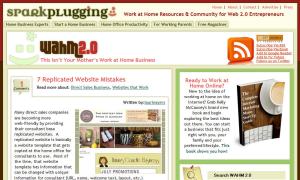Guest Post by Lisa Robbin Young
There’s a horrible face of direct sales that, to my chagrin, I see more and more often now that I’m a coach.
The face of fear.
Maybe I was lucky as a young “orphaned” consultant, because I never really saw fear rearing it’s ugly head in my business.
But now that I work with other consultants regularly, I’m hearing the tell-tale signs of decades of fear that have permeated our industry.
“I’m afraid to give that booking to my new recruit because it means I’ll loose that train.”
“I’m afraid to share my ideas with others because it means I have to work harder in my own business.”
“I’m afraid of the fact that there are SO many other XYZ consultants in my area.”
And this is not your run-of-the-mill, everyday “fear”. This fear has a distinct aroma…
“I’m afraid to share the opportunity with her because she’s such a great hostess!”
“There are so many direct sales companies now selling the same kind of stuff, it’s just hard to compete.”
…It’s the fear of competition.
Its an easy trap to fall into. The belief that everyone and everything out there is “just like you”. Sadly, this problem is most apparent when examining teams within our own company – and even within our own downlines.
Top leaders in some well-known companies even propagate this nonsense by having consultants sign non-disclosure agreements at training events. I’ve not yet seen this at the corporate level, and hope I never do! The very thought that direct sellers would be reluctant to share what is working for them with others seems the antithesis of the direct selling concept: a rising tide raises all ships.
How does this tie into Social Media?
Social Media is a possible cure for this cancer we know as fear.
Via blogs, social media, and even newsletters and personal (not company owned) websites, a consultant can express his/her uniqueness – that thing that sets them apart in the marketplace.
The title of this post is one of the mantras that pervades my coaching: YOU, the consultant, are the most important product your company has to offer. It’s not your catalog items, host benefits, or even the comp plan. It’s the very nature of who YOU are, and what YOU bring to the table that makes you a valuable piece of the direct selling puzzle.
Think on this: at every party/presentation you attend, what is the ONE product that every guest will experience before the end of the evening? And what one product is very likely to NOT be in the catalog everyone is holding in their hands?
The consultant.
You make the difference. As a consultant, you are the face, the living breathing, interacting product that clients come to know, like, trust, and even make repeat orders for when they book parties over and over again.
The consultant is the best selling product of every direct sales company. When that product is no longer available, the company no longer exists.
So if it follows that you are a best-selling product, and you’re NOT in the catalog, shouldn’t SOMEONE be marketing your skills, abilities, availability and the benefits that you provide that are unique to you?
Enter Social Media & Online Marketing.
Social media is a communication platform that can no longer be ignored or poo-pooed. Jen is one of a handful of people that understand and communicate the value of that platform.
But social media is just one piece of the online markting puzzle. In Jen’s “preaching to the choir” post, she mentions newsletters. While not exactly a social media platform, content-driven communications are what separate the social media leaders from the also-rans.
Look at any trainer in the direct selling industry today and they are all using e-zines to reach out to their lists in a value-added way. I do it (online marketing for direct sellers is my specialty), Jen does it – even Tony Robbins does it! A newsletter/ezine is the single most effective way to consistently reach your target market.
Target marketing is another key coponent to your effectiveness in business. But Jen asked me to stay on the social media topic, so you’ll have to find me on my blog to hear about that.
Content is NOT a coupon or an announcment about the ‘greater than sliced bread’ offers your company has coming up next month. It’s not an enticement to “book now before my calendar is filled”. Those things have their place in a newsletter, but in reality, should make up no more than about 25-30% of the total content in the newsletter.
What kind of content CAN you include? Tips, hints, time and money saving ideas related to your product line are all great places to start. You can even recommend (in passing) a product from your collection that fits perfectly for the tip. But the content should be valuable whether or not you recommend your products or services. THIS positions you as an expert that is more interested in helping your target market than hawking your wares to anyone that’ll open your newsletter. Plus, it gives you the opportunity to share a little bit about who you are as a human being – a person with successes, kids, flaws, cravings, faux pas – warts and all.
It will require a little more work on the front end, but the return on investment is huge. Like Jen, I enjoy a very high open rate on my newsletters, which only confirms that I’m providing content that works for my market. And because I can monetize that traffic, it also yields a tidy little income from people across the country (or around the world) that I would NOT have earned any other way. It’s hard to do a party in California when you live in Michigan!
And content that you create for your blog can be re-used in your newsletter (and vice versa). Repurposing is TOTALLY acceptable, and it cuts the workload down. I frequently post my ezine articles to my blog for people that haven’t already subscribed.
Ideally, companies would come on board with this, and start sharing more helpful content in their customer newsletters, but that is not the job of the corporation. Not to be too blunt here, but the company’s job is to help you sell more of their products and services. They’re in business to make money – and it’s reasonable to expect that their obligation begins and ends with their product line. That’s a forseeable, controllable situation for them. Consultants (in all their varieties) are an unknown.
YOU are in business to make money as well. So it behooves you to have your own method of consistently reaching out to your customers in a value-added way. The simplest, easiest way to meet your prospects where they are is the humble e-zine.
It can be text only – it doesn’t need to be pretty. It DOES need to provide value in such a way that people look forward to getting it, reading it, and USING it.
It is your responsibility as the owner of “You, Incorportated” to share with your prospects, clients, recruits, etc, the value of who you are, what you have to offer, and what sets you part in a field of hundreds, thousands, or even millions of other consultants in your very own company. When you do that, you don’t see competition anymore, because no one else is quite like you. You are the only you there is, and while this may sound a bit “Pollyanna”, it still rings true. When you no longer see yourself as a commodity, no one else can compete with you. Thus, competition fades, and all that’s left is YOU serving your target market to the best of your abilities – while your target market loves you more and more for it!
It’s the relationship you build that determines whether they do business with you (perhaps from across the continent) or the consultant down the street.
Social media, blogs, ezines, and the like make building and maintaining those relationships happen faster & more efficiently. Sometimes without those venues, it wouldn’t happen at all. And from an economic standpoint, you’ll stand a far better chance of surviving downturns when your income isn’t tied to your local economy, but is diversified across different localities. The Internet makes that possible for everyone.
But you can’t rely on your company to do it for you. That’s not their job. You’re a business owner, and it’s your job to promote YOU. If you don’t do it, who will?
(c) 2009 Lisa Robbin Young. All Rights Reserved.
==========
Lisa Robbin Young created the first certified Direct Sales Marketing Coaching program and teaches direct sellers how to transform their expensive hobby into a real business. Leaders, coaches and trainers look to Lisa for online marketing strategies that deliver results. Learn more about the Home Party Solution Live Workshop and sign up for her free weekly ezine, “PartyOn!” at http://www.homepartysolution.com
Read Full Post »
 One of the biggest concerns I hear from direct sellers when they contemplate blogging is the fear of what to write about. “How will I think up new stuff to write all the time?” “I’m not an expert on anything!” As a result, they paralyze themselves into complete inaction.
One of the biggest concerns I hear from direct sellers when they contemplate blogging is the fear of what to write about. “How will I think up new stuff to write all the time?” “I’m not an expert on anything!” As a result, they paralyze themselves into complete inaction. Social media activities for direct sellers are primarily focused around two activities: relationship development and list building. Through a content-marketing strategy, a direct seller provides free, actionable content that prospects can use right now without spending a dime. After that, the direct seller builds relationships with prospects through social networking tools, and invites those prospects to consume her content. If the prospect finds value in the content, that prospect may subscribe, and at that point, the list begins to be built. You ONLY have permission to market to that prospect once they have opted in to your list.
Social media activities for direct sellers are primarily focused around two activities: relationship development and list building. Through a content-marketing strategy, a direct seller provides free, actionable content that prospects can use right now without spending a dime. After that, the direct seller builds relationships with prospects through social networking tools, and invites those prospects to consume her content. If the prospect finds value in the content, that prospect may subscribe, and at that point, the list begins to be built. You ONLY have permission to market to that prospect once they have opted in to your list.
 It’s pretty easy to design a blog to find new customers for your business. Simply identify the problems your customers have (related to your product line), and then provide simple, actionable solutions that your prospects can use right now without spending a dime. As your readers come to know, like, and trust you, they may become customers for your business.
It’s pretty easy to design a blog to find new customers for your business. Simply identify the problems your customers have (related to your product line), and then provide simple, actionable solutions that your prospects can use right now without spending a dime. As your readers come to know, like, and trust you, they may become customers for your business. I love analytics. I really do. In fact, I’ll go so far as to say I’m an analytics junkie. Why? Because analytics are validation. They show how your social media efforts are paying off, and what you should be spending your time on. It’s the hard data that you can use to find out if what you’ve done is bringing you the traffic that can make you money, or if it’s a complete waste of time.
I love analytics. I really do. In fact, I’ll go so far as to say I’m an analytics junkie. Why? Because analytics are validation. They show how your social media efforts are paying off, and what you should be spending your time on. It’s the hard data that you can use to find out if what you’ve done is bringing you the traffic that can make you money, or if it’s a complete waste of time.
 As a direct sales executive or salesperson, it is important to read and comment on other blogs targeted at your niche. I’m often asked why this is. There are several reasons why this approach can be beneficial for your business.
As a direct sales executive or salesperson, it is important to read and comment on other blogs targeted at your niche. I’m often asked why this is. There are several reasons why this approach can be beneficial for your business.






